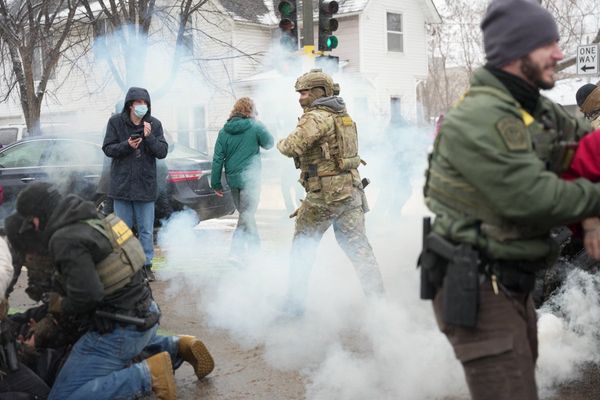LOS ANGELES — California state officials released a pandemic plan Thursday that gives an overview of how authorities will manage potential new surges, warning that while the omicron surge is fading, the state must be prepared for the emergence of new variants and seasonal increases in coronavirus transmission.
That means being prepared for a bump-up in coronavirus cases as the school year begins in the late summer, and a higher surge just as winter gets underway, officials said. It also means there may be instances when universal indoor mask orders are needed for limited periods of time to avoid overwhelming hospitals and ambulances responding to 911 calls.
The plan calls for stockpiling a robust supply of masks, maintaining the capacity to administer hundreds of thousands of vaccine doses and coronavirus tests per day, and enhancing the ability to track COVID-19 trends and respond to hard-hit communities. It’s now clear that there will need to be a years-long fight against COVID-19, officials said Thursday.
The unveiling of the new plan comes as authorities remain upbeat about continued plunges in coronavirus cases and hospitalizations, and reiterated they could be prepared to ease additional restrictions, such as the indoor mask mandate in K-12 schools, in a matter of weeks. On Wednesday, the state lifted a 2-month-old mask order for vaccinated people in indoor public spaces, with only a handful of areas in the state — Los Angeles, Santa Clara and Mendocino counties, and Palm Springs — retaining the orders, likely for a few more weeks.
“Today is not about moving on but, rather, about moving forward,” California health and human services secretary Dr. Mark Ghaly said. Now, with understanding under our belt of how to rapidly assess a new variant, “we’ve moved in a relative state of fear for much of the last few years. We can now balance these concerns by being smarter.”
But the document is more battle plan than “mission accomplished” banner — an acknowledgement both of the progress made so far and the continuing need for California to be prepared to respond nimbly to any tricks the virus may still have up its sleeve.
“We move into this next phase with humble confidence and a commitment to be active and aware every step of the way. We move into the next phase smarter than we ever have been,” Ghaly said.
Even as California state officials have dropped an indoor mask mandate statewide for settings such as stores, restaurants and gyms, Ghaly and other health officials have suggested there may come a time when it might be appropriate to re-implement mask orders to keep hospitals from becoming overwhelmed again.
“The fact that masks work should not be the debate,” Ghaly said. “We should work together to make sure those who benefit most have access to the highest quality masks we can provide. And at times there may need to be a time when we all wear masks to get through certain situations, so we don’t overwhelm our healthcare delivery system.”
Ghaly’s comments echoed those made by Dr. Rochelle Walensky, director of the U.S. Centers for Disease Control and Prevention, made on Wednesday. “We want to give people a break from things like mask-wearing, when these metrics are better, and then have the ability to reach for them again should things worsen,” Walensky said.
Ghaly didn’t lay out a specific plan Thursday for when masks might be required again in indoor public settings but outlined a four-tier system for telegraphing the urgency by which masks should be recommended or required — the lowest urgency level defined as masks being optional, then going up to a recommendation, a strong recommendation, then a requirement.
The metrics by which California might have to reinstitute mask mandates or otherwise respond to a potential new variant will depend on the new strain itself. A particularly deadly variant might require a focus on preventing new cases, Ghaly said. But a less virulent virus, even one that is more transmissible, may result in more attention to hospitalization rates.
Currently, Ghaly has said the state is strongly recommending masks still be worn in indoor public settings. “For some, the strong recommendation that we currently have should be heeded as the time to use a high-quality, high-filtering mask as a life saving tool — those with underlying conditions; those who are immunocompromised, those who can’t yet for one reason or another be vaccinated.”
The acronym “SMARTER” represents the approach outlined in the state plan, which is anchored around seven key areas: shots, masks, awareness, readiness, testing, education and Rx (or therapeutics).
Included in the 30-page document are specific benchmarks. Among them are ensuring the capacity to administer at least 200,000 vaccines and 500,000 tests a day, as well as stockpile of 75 million high-quality masks that can be distributed as necessary.
California also plans to maintain wastewater surveillance and continue to genomically sequence at least 10% of positive test specimens to track trends or the potential emergence of new variants.
Officials also plan to expand school-based vaccination sites by 25%.
“It is clear the virus will remain with us for some time, if not forever. It is less clear how often and how much it will continue to impact our health and well-being. However, we know what works and have built the necessary tools over the last two years that allow us to learn and hone our defenses to this virus as it evolves,” the plan states.
After all, California has seemed on the cusp of finally getting its arms around COVID-19 before, only to be broadsided by the arrival of some freshly mutated variant.
“We aren’t out of the woods. We are just more familiar with the woods and don’t need to live fully afraid of what’s behind the next tree,” Ghaly said.
As an example of the way the plan’s approach would function in the real world, the report outlines how California might react to a sudden rise in new cases in a region.
Officials would work to analyze coronavirus samples to see whether a new variant has been identified and, if so, research the strain to determine whether it’s more likely to infect those who have been vaccinated or previously had COVID-19. State officials would then deploy testing supplies to areas with rising transmission, facilitate the deployment of medical workers to areas expected to be hard hit and work with local partners to ensure residents are informed of what is happening and how they can protect themselves.
The plan arrives at a time of guarded optimism in California. The recent wave triggered by the hyper-infectious omicron variant is rapidly receding, and the numbers of both daily new cases and coronavirus-positive hospitalizations are plummeting.
Over the last week, California has reported about 15,000 new coronavirus cases a day, according to data compiled by The Times. That’s well below the omicron peak of more than 123,000 cases a day but roughly the same level as the height of last summer’s deadly surge.
On Wednesday, 7,271 coronavirus-positive patients were hospitalized statewide — less than of the omicron-era peak of 15,435, which was recorded Jan. 21.
Deaths, the final devastating indicator of coronavirus spread, remain high, however. Nearly 1,500 Californians have died from COVID-19 in just the last week, pushing the pandemic’s total toll to nearly 82,400.
Seven out of 10 Californians are already fully vaccinated, according to data compiled by The Times. Nearly 70 million total doses have been administered statewide to date.
Times staff writer Taryn Luna contributed to this report.







